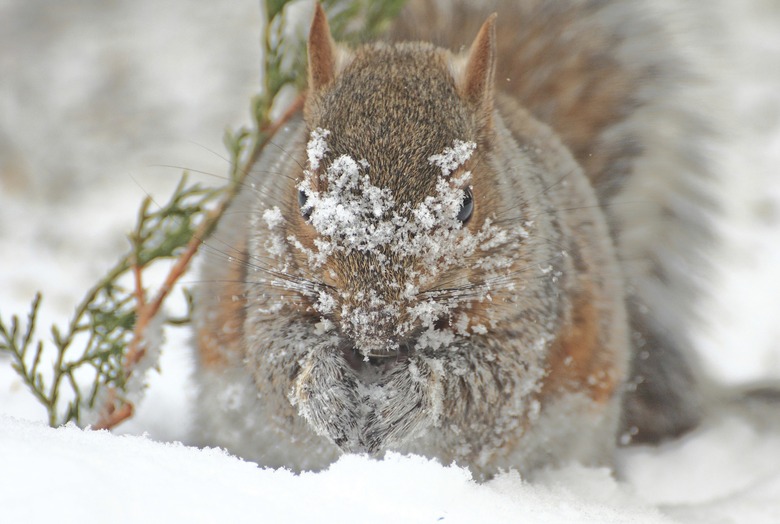How Does A Squirrel Survive In The Winter?
Squirrels belong to a large family including tree squirrels, ground squirrels and flying squirrels, and each kind survives winter differently. Tree squirrels have large ears, long bushy tails and sharp claws; flying squirrels have a membrane that extends between their wrists and ankles to help them glide between trees; and ground squirrels are stout and have short, strong forearms for digging.
About 279 squirrel species exist around the world, from deserts to rainforests and woodlands to Arctic regions. Where do squirrels go in winter? It depends on the species and the environment they live in. Many species of squirrel hibernate for months at a time while other species nest/hibernate periodically and emerge once in a while to search for whatever food is still available.
Eastern Gray Squirrel
Eastern Gray Squirrel
Living in the eastern half of North America and southern Canada, the eastern gray squirrel (Sciurus carolinensis) survives winter by hoarding nuts. In fall, the squirrel gathers nuts and buries small hoards across the woodland floor. When little food is available, the squirrel retrieves its hoards through a keen sense of smell that can detect them through 30 cm (1 foot) of snow.
During severely cold winter weather, it stays in its den or nest for several days at a time and ventures out at midday when temperatures are warmest, altering its normal dawn and dusk activity times. Female eastern grays with young may delay weaning a late-summer litter until winter is over.
Southern Flying Squirrel
Southern Flying Squirrel
The southern flying squirrel (Glaucomys volans) reduces activity during the winter months to survive. These squirrels inhabit the eastern half of the United States from southern Florida to south-eastern Canada. Where do squirrels sleep at night in the winter? The southern flying squirrel nests in groups during winter to benefit from shared radiant heat, locating and keeping track of other squirrels through high-pitched "cheeps."
It also reduces its body temperature and metabolic rate in winter, but doesn't enter hibernation. During cold weather, the squirrel becomes less active, venturing out more rarely to feed on its winter diet of seeds, hickory nuts, acorns and wild cherry pits.
Thirteen-Lined Ground Squirrel
Thirteen-Lined Ground Squirrel
Named for the 13 spots or spotted stripes that run along its back, the thirteen-lined ground squirrel (Spermophilus tridecemlineatus) hibernates over winter. Capable of surviving up to six months with no food or water, the thirteen-lined ground squirrel retreats to its underground burrow by October and doesn't reappear until March.
The squirrel's body temperature drops to a few degrees above 0 Centigrade (32 degrees Fahrenheit), its metabolic rate slows down and it enters a state called "torpor." Periodically throughout winter the squirrel rouses and its temperature rises to near-normal levels, then it returns to a torpor state. The thirteen-lined ground squirrel uses up most of its body fat during hibernation.
Arctic Ground Squirrel
Arctic Ground Squirrel
A master of winter survival, the Arctic ground squirrel (Spermophilus parryii) endures temperatures as low as -30 degrees Centigrade (-22 degrees Fahrenheit) outside its underground burrow. During hibernation, its body temperature falls to -3 degrees Centigrade (26.6 degrees Fahrenheit), and its blood loses all water molecules, which prevents ice crystals from forming. The Arctic ground squirrel hibernates for about eight months.
Brian Barnes of the University of Alaska in Fairbanks conducted a study in 2012 which found that males wake up three weeks earlier than females but remain in their burrows, feeding on stored supplies. The study also found that the lowest temperature a hibernating Arctic ground squirrel could endure without waking up was -26 degrees Centigrade (-14.8 degrees Fahrenheit).
References
Cite This Article
MLA
Green, Jenny. "How Does A Squirrel Survive In The Winter?" sciencing.com, https://www.sciencing.com/squirrel-survive-winter-4612243/. 12 June 2019.
APA
Green, Jenny. (2019, June 12). How Does A Squirrel Survive In The Winter?. sciencing.com. Retrieved from https://www.sciencing.com/squirrel-survive-winter-4612243/
Chicago
Green, Jenny. How Does A Squirrel Survive In The Winter? last modified March 24, 2022. https://www.sciencing.com/squirrel-survive-winter-4612243/
